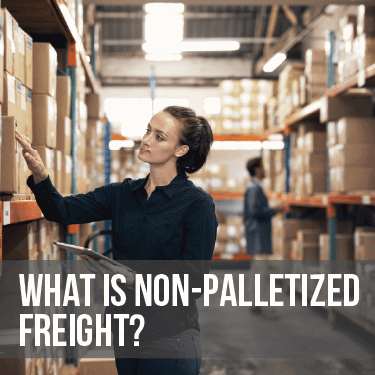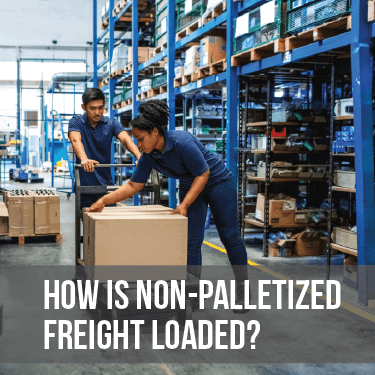One of the most common items in the freight shipping industry is the simple pallet. Pallets have been in use for more than 80 years and are used to load and organize freight for shipping. However, a good portion of goods shipped in the U.S. are classified as non-palletized freight.
Non-palletized freight is considered any type of freight that is not secured by a pallet. Because this type of freight is traveling without the security of a pallet, specific load techniques are used when they’re put into a trailer. Non-palletized freight is transported using the same methods as regular freight.
In this article, we will discuss everything that you need to know about non-palletized freight.

Non-Palletized freight is also referred to as floor-loaded freight. This type of freight constitutes any type of cargo that is not secured by a pallet. Products that are too small to be safely secured by pallets fall under this category of freight.
Numerous benefits come with shipping freight without using a pallet. One of the benefits is that not using pallets can reduce your shipping costs. There are a few reasons for this:
Non-palletized freight is loaded from floor to ceiling which utilizes all the space available in a trailer or container. Multiple non-palletized freight shipments also share the same trailer or container as well.
There are a few downsides to making palletless shipments that you should be aware of. More fragile freight shipments are not suited for shipping without a pallet. This is because they are more likely to be damaged.
While shipping freight costs for palletless freight might be cheaper, labor costs are likely to be higher. The loading and unloading of non-palletized freight has to be done by hand. Unfortunately, handling the freight manually like this is a much longer process which makes receiving and logging in stock longer as well.
Heavier types of products that are shipped without pallets are especially difficult to load and unload. A good weight limit to use when deciding whether or not you should use this shipping method is 130 pounds.
If you are planning to ship freight that exceeds this weight limit, then you should consider placing it on a pallet. Using pallets for freight that weighs this much will make loading and unloading more efficient for dock workers.
Shipping freight without it being secured to a pallet might seem reckless. However, non-palletized freight is fairly common in the shipping industry.
In 2020 there was about 12.5 billion tons worth of freight shipped nationwide. The standard pallet can carry a little over two and a half tons. Each year, about 1.9 billion worth of shipping pallets are used.
That leaves 4.75 billion tons of freight distributed by the 1.9 billion shipping pallets each year. This means that the rest of the 7.75 billion tons that travels the nation is shipped as non-palletized freight.
| Total Freight Shipped Throughout the U.S. In 2020 | 12,500,000,000 |
| Freight Shipped On Pallets | 4,750,000,000 |
| Non-Palletized Freight Shipped | 7,750,000,000 |

Loading non-palletized freight requires the utmost care. Since products aren’t secured by a pallet, there is a higher likelihood that they can bounce around and get damaged in the trailer or container that carries them.
This can be difficult because palletless freight can vary in size, shape and weight. These factors could cause stacked freight and packages to tip over. Because of these factors, palletless freight must be loaded carefully.
As we mentioned earlier, non-palletized freight is loaded into containers and trailers from floor to ceiling. While loading freight in this manner might sound self-explanatory, there are still important steps that need to be followed to ensure the freight is loaded properly.
Guidelines for loading non-palletized freight might have slight variations but they will all roughly follow the steps above. Freight companies have these guidelines to not only ensure that non-palletized freight arrives safely, but to also maintain safety.
If non-palletized freight is loaded improperly it could potentially fall on the dockworker loading the trailer or container. Another possibility is that non-palletized freight contents that are loaded improperly at one terminal could end up falling on a dock worker when they are unloaded at another terminal.
While non-palletized freight should be loaded properly, regardless of what it's loaded into, it is by far most important for it to be loaded properly into trailers. This is because trucks move around 72 percent freight around the nation. This means that the trailers carried by the trucks are loaded and unloaded the most.
Non-palletized cargo is shipped the same way that palletized cargo is. Non-palletized freight can travel by ship, plane, cargo containers, trailers and by train. Another popular method of transport for non-palletized freight that most people have experienced is by a delivery truck.
At USA Truckload Shipping you will find a dedicated team that will help you transport your freight, palletized or non-palletized. We will get your freight to where it needs to be using fast and cost-efficient routes.
After many years of experience in the industry, USA Truckload Shipping has forged a well-connected network of partners spanning all across the country. These partnerships help give us an edge over our competition by ensuring that every customer's ship is handled with care.
The focus of our team at USA Truckload Shipping is to ultimately build a lasting relationship with our customers. Contact us today and we can get all of your shipping needs taken care of.
R+L Global Logistics
315 NE 14th St., Ocala, FL 34470